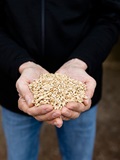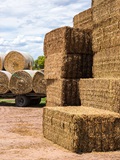Hay Report
Dairy Australia generates a hay report to help farmers make more informed decisions when buying hay. The hay report is updated 40 times per year and provides an independent and timely assessment of hay markets in each dairy region.
Hay prices by location
-
Queensland
-
New South Wales
-
Victoria
-
South Australia
-
Western Australia
-
Tasmania
Select a location to view the hay price:
-
Cereal
N/ALucerne
N/AStraw
N/APasture
$330 - $450Steady -
Cereal
$240 - $320SteadyLucerne
$350 - $440SteadyStraw
$90 - $110SteadyPasture
$230 - $325Steady -
Cereal
$250 - $330SteadyLucerne
$340 - $410SteadyStraw
$80 - $120$5Pasture
$240 - $300Steady -
Cereal
$280 - $335$5Lucerne
$340 - $430SteadyStraw
$80 - $130$5Pasture
$260 - $300Steady -
Cereal
$280 - $380SteadyLucerne
$400 - $470$5Straw
$120 - $180$10Pasture
$310 - $370Steady -
Cereal
$270 - $330SteadyLucerne
$370 - $450SteadyStraw
$110 - $160$5Pasture
$220 - $260Steady -
Cereal
$275 - $315SteadyLucerne
$340 - $410SteadyStraw
$95 - $120$3Pasture
$240 - $280Steady -
Cereal
$260 - $330SteadyLucerne
$350 - $410$10Straw
$90 - $100SteadyPasture
$220 - $260$5 -
Cereal
$270 - $320SteadyLucerne
$330 - $390SteadyStraw
$90 - $115SteadyPasture
$235 - $270$3 -
Cereal
$260 - $325-$5Lucerne
$320 - $380-$10Straw
$90 - $110SteadyPasture
N/A -
Cereal
$300 - $360SteadyLucerne
$370 - $450SteadyStraw
$110 - $135SteadyPasture
$230 - $270Steady -
Cereal
$245 - $320SteadyLucerne
$310 - $380$5Straw
$85 - $130SteadyPasture
$275 - $365$10
National Summary
-
Hay Report - 26 April 2024PDF, 1.01 MB
All Location Hay Prices
| 26 April 2024 |
Cereal |
Lucerne |
Straw |
Pasture |
|
|---|---|---|---|---|---|
Atherton Tablelands | Price range
Change | N/A | N/A | N/A | $330 - $450 Steady |
Darling Downs | Price range
Change | $240 - $320 Steady | $350 - $440 Steady | $90 - $110 Steady | $230 - $325 Steady |
North Coast NSW | Price range
Change | $250 - $330 Steady | $340 - $410 Steady | $80 - $120 $5 | $240 - $300 Steady |
Central West NSW | Price range
Change | $280 - $335 $5 | $340 - $430 Steady | $80 - $130 $5 | $260 - $300 Steady |
Bega Valley | Price range
Change | $280 - $380 Steady | $400 - $470 $5 | $120 - $180 $10 | $310 - $370 Steady |
Gippsland | Price range
Change | $270 - $330 Steady | $370 - $450 Steady | $110 - $160 $5 | $220 - $260 Steady |
Goulburn & Murray Valley | Price range
Change | $275 - $315 Steady | $340 - $410 Steady | $95 - $120 $3 | $240 - $280 Steady |
South West Victoria | Price range
Change | $260 - $330 Steady | $350 - $410 $10 | $90 - $100 Steady | $220 - $260 $5 |
South East SA | Price range
Change | $270 - $320 Steady | $330 - $390 Steady | $90 - $115 Steady | $235 - $270 $3 |
Central SA | Price range
Change | $260 - $325 -$5 | $320 - $380 -$10 | $90 - $110 Steady | N/A |
South West WA | Price range
Change | $300 - $360 Steady | $370 - $450 Steady | $110 - $135 Steady | $230 - $270 Steady |
North West Tasmania | Price range
Change | $245 - $320 Steady | $310 - $380 $5 | $85 - $130 Steady | $275 - $365 $10 |
About the Hay Report
Why the hay report is created
Farmers, government, industry advocacy and businesses across the supply chain require independently produced, unbiased data on the industry to inform strategic decisions and policy formation.
Hay reports provide an independent industry view, bringing together key data and insights across the supply chain and industry without any vested interest.
The hay report is created using data provided by the Australian Fodder Industry Association (AFIA).
Interpreting the reports
Hay prices are based on shedded hay without weather damage, of good quality and colour. There is a wide variation in quality for hay, so prices are indicative for a mid-range product.
Prices are estimates based on delivery to dairy farms with allowance for freight, storage, and marketing costs, but exclusive of GST. Actual prices may vary for quality or other reasons.
In this video, dairy farm manager Brian Corr explains how Dairy Australia's hay and grain email updates help him make more informed decisions on-farm.





